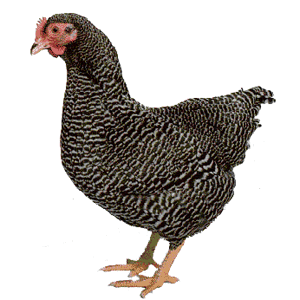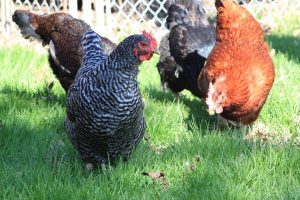Plymouth Rock History
The Plymouth Rock is one of Americas oldest breeds. Your grandmother probably raised them, am I right?! It simply is the all American bird, it has good egg laying ability and was seen in nearly every American backyard. Its even nicknamed ‘Americas Favorite Breed’. A bird of that era that had similar accolades was the Rhode Island Red, which is still popular today.
The Plymouth Rock was knocked off the top spot after WW2 in favor of breeds with better egg laying capabilities. These new breeds were often developed just for egg laying and were the pre requisite to the various strains we see today in commercial farms.
The Plymouth Rock was first exhibited at America’s first poultry show, in 1829 in Boston. It is believed that these original fowls lost their identity and that the progenitors of present Barred Plymouth Rocks were first exhibited in 1869 at Worcester, Massachusetts. These were composites of several blood lines.
The first and most prominent cross was that of a Dominique male with Black Cochin or Black Java females, which was originally made at Putnam, Connecticut. This Plymouth Rock was recognized as a distinct breed and was admitted to the first American Standard of Excellence, in 1874. Not know all that!
This breed has always been popular owing to the intricate barring on the feathers. If you look closely you will see that every feather should end in a black tip.
Whether the Plymouth Rock originated from a Dominique-Black Cochin or from a Dominique-Black Java cross is a debatable question. Both have actually been used synonymously in show classification.
Are Barred Rock and Plymouth Rock chickens the same?
Just for clarification the Barred rock and Plymouth Rock are the same chicken.
A lot of people just refer to them as ‘Barred Rocks’. This is just their short name; to give them their correct title, it’s the ‘Barred Plymouth Rock’. Fancy!
The Plymouth Rocks are great looking, lay fantastically well nearly all year round, are children friendly and have character in abundance.
Read on to find out more…..
Eggs
Size
Large
Color
Light Brown – Brown
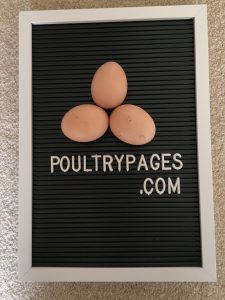
Production per year
200-280 (the white variety are said to the best layers as they were bred purely for laying)
When do they start laying eggs?
Slightly later than other breeds, at around 23 weeks
Plymouth Rock Characteristics
Temperament / Are they good as pets?
Oh yes great pets, they love humans interaction. They are especially good with children too as they are more robust, than say a Silkie. Children can sometimes be slightly heavy handed but the Plymouth’s don’t seem to mind.
Temperament wise, they are sweet and loving and actually I’ve found to be very intelligent caring birds. They are top of the pecking order, this means you might see some bossy going on to other birds. These birds rule the roost.
They make an excellent choice for any backyard coop and they very rarely go broody.
How do I tame Plymouth Rock chickens?
Took me a little longer to get these girls to trust me so I can pick them up and give them a cuddle. As I said they are intelligent, so they assume when I walk over to the coop I have either feed or treats for them. Meaning sometimes it’s a cuddle in exchange for some fruit or meal worms. Cupboard love ay?!
The absolute best way though is simply start early. Handling chicks 2, 3 or 4 times a day will mean by the time they are adults they are used to being picked up. It’s mostly cuddles but there is a serious side, you ought to be able to handle chickens to assess their health and welfare from time to time.
How many do I need to buy?
If you want LARGE brown eggs and lots of them, you should buy as many Plymouth Rocks as you can! Chickens are social creatures so I never recommend keeping just one. A minimum of a pair, but the best number for a small backyard flock is about 6. You can always scale up from here – which people do. Raising chickens is so addictive, remember I told you!
The best ratio of males to females with this breed is 10:1. So for every 10 females you need 1 male. Why is this important? You need a happy roost and for that you need balance.
Barred rocks are heat and cold hardy, making them great for hot humid countries like Malaysia, Philippines, India and Sri Lanka.
In the cold they thrive in the European winters and winters of North America, making them a very versatile bird and should be a definite contender for your flock.
How long will Plymouth Rocks live for?
Barred Rocks will live for 8+ years, even longer if raised free range and can keep fit like mine. So you’ve easily got 6-7+ good years of fresh eggs ahead of you – which is awesome!
How much space do they need?
People quoting 2-5sqft per bird, run space isn’t enough in my experience. The Plymouth rocks like a bit more space, too ‘cooped’ up (pun intended) and they will be pecky with other birds. They also just get sad, wont lay as much and be generally unhappy. 20-25sqft per chicken is what I recommend here. Mine are now all free range but there was a time when they weren’t so I’ve seen it with my own eyes, over 30 years.
You’ll need a fence! Oh my will you need some good fencing. Ignore what the books and ‘experts’ say online, all mine have always been great fliers. I think it’s that independence thing again. ‘’Ill do what I wanna do, when I wanna do it’’.
I mean they hop back over the fence at dusk and there has never been an issue so hey, I let them do it………
They will fly over a 6 foot fence, so if you are keeping them in the run during the day I recommend having a net over the top. It a fairly inexpensive way to stop them from escaping.
They roost at 2-4ft off the floor, bare this in mind when choosing a coop. Make sure the roosting bars are high enough off the floor. If they aren’t and the nesting boxes are higher, they will roost in there. This isn’t great as they will poop in them and ruin the boxes for nesting very quickly.
Ill recommend some coops later on, that Plymouth’s will love.
Will they mix with my other chickens?
Yes, they won’t socialize that much with them, everyone says the same thing. They always see the Barred Rocks out on their own foraging and wondering when free range. If in confinement they can be bossy, this comes with being top of the pecking order I’m afraid.
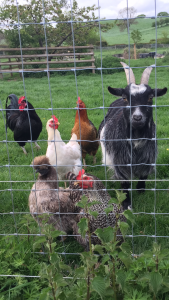
They sometimes won’t do well, if in confinement, with docile breeds. So that’s breeds like Silkies and Bantams. Mine had a thing for a while with pecking the crest feathers of the Polish chickens. It didn’t last long I think it was just the Barred Rock letting the Polish know the hierarchy in the coop after she was first integrated.
If any bullying occurs for prolonged periods then you will have to separate the offenders. There nothing nice about it, I’ve had to do before with certain breeds and others have had to do it too.
If any chickens start to show aggression whether its uncharacteristic or not, it’s usually due to stress. Stress triggers some aggressive traits, things to consider here are:
- Is the coop large enough?
- Is the run large enough?
- Are the birds at the right temperature. i.e the Goldilocks zone – not too hot and not too cold?
- Are there alot of predators around, making them scared and stressed ?
Appearance
Plymouth Rock chicken recognized variety
In the US they have recognize seven varieties those are:
Barred, Blue, Buff, Columbian, Partridge, Silver-penciled and White.
In the U.K the Poultry Club of Great Britain did take a slightly more conservative approach only recognizing 5 varieties. These were the Barred, Black, Buff, Columbian and White. They have now included the Blue, Partridge and the Silver Penciled to make 8 recognized varieties.
The partridge of silver penciled are my favorite they are absolutely gorgeous and make ok layers.
Barred Plymouth Rock
Plumage is white with a blueish hint barred with beetle green or black sheen. The sharply defined bars are to be straight, fairly narrow and of equal breadth. Every feather should have a black tip and the fluff or under color is barred too.
Eyes are a rich-bay. Legs, feet and beak yellow, with the face, ear lobes, wattles and comb all being red.
If you can find all that, you have a great looking chicken which will be the envy of all keepers.
Blue Plymouth Rock
One even shade of blue, light to dark, but a medium blue is preferred by breeders and judges, a clear solid blue is best, free from pepper, sandiness or a bronzing, and quite free of lacing.
Eyes reddish-bay. Comb, face, wattle and ear lobes bright red. Feet and legs always are yellow.
Again, find this in a Barred Rock and your onto a winner!
White Plymouth Rock
A great color for people wanting the best egg layer. ‘The Whites’ are said to be the best egg layers amongst all the Plymouth colors. Becoming more and more popular I think it will rival the Rhode Island White in numbers soon enough!
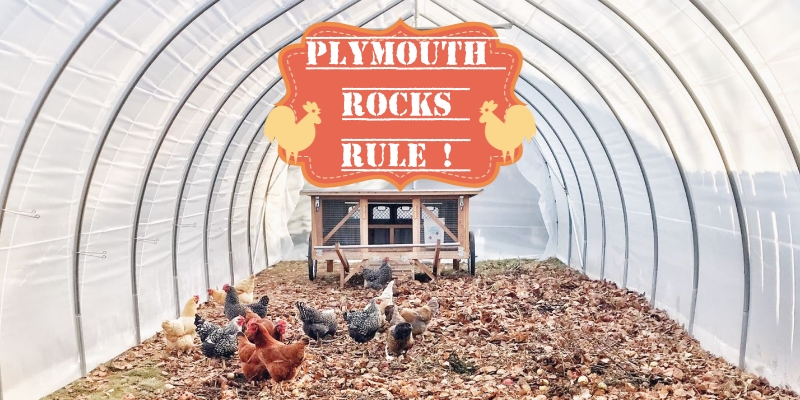
Dominique vs Barred Rock
We answer this question on our dedicated page here. We have 5 SUPER EASY ways to tell them apart!
Feeding
What should I feed them?
Chicks should be fed ‘chick crumb’ or ‘chick starter’, it’s the same thing just called differently. This contains the correct nutrients to give your chicks the best start. They should be fed this up until 6 weeks.
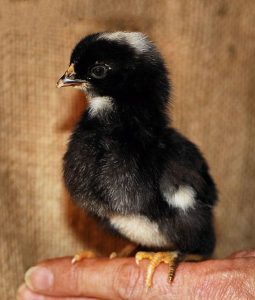
At 6 weeks switch them onto ‘growers mash’ or ‘growers pellets’ again same ingredient. But only this time pellets are slightly different to the mash. The mash is fine powder, but the pellets are in pellet form. It simple enough you cant go wrong. Either is fine for them to eat Plymouth’s can handle both.
They will come onto lay, on average, around the 23rd-24th week. So at around week 22 I switch them onto layers pellets. The layers pellets contain all the right nutrients so that they are able to start producing your wonderful eggs!
They will then eat this until they stop laying, which is at around a year or two before they die. You can just carry on feeding them layers pellets, especially if you have other hens eating the same thing, it’s no harm to them.
Chickens need grit! Grit helps chickens to digest their food as the grit is swallowed and stored in the gizzard. When in the gizzard it crushes up whatever they eat so they can digest it properly. Oyster shells work great and can be bought so you haven’t got to go oyster picking. Or eggs shells work great too, grandma’s old secret was to dry out egg shells and crush them up.
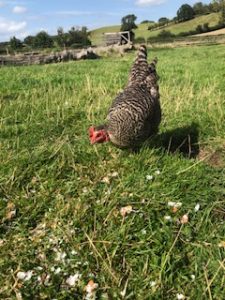
How much should I feed them?
As chicks, they should have access to a feeder and feed 24/7. It just easier like that as they will sleep sometimes during the day and maybe eat a lot at night. They haven’t quite settled into a eating/sleeping routine. Fresh water should be available too at all times!
Now as adults, they will eat 2.8oz.(80g) to 4.2oz.(120g), that’s per day. Less during the summer when its really hot and slightly more during winter to keep warm.
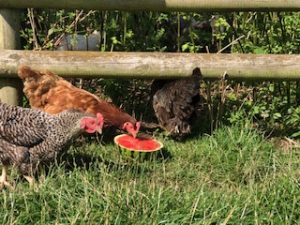
During the winter I supplement with some handfuls of corn too. Corn is great it really helps to keep chickens warm. If you buy in your feed having a corn and seed batch would be a great idea.
Now in the summer when they are eating less and need more water. I actually supplement their feed with fruits that have a high water content. They can then eat but also cool down too.
So mine love watermelon, they go absolutely mad for watermelon. They love cucumber too, apples, pears they’ll eat anything really.
What can’t they eat?
Chickens, and this applies to all breeds, can’t eat beans or chocolate. It’s so serious as it causes them to cardiac arrest. You have to be really really vigilant if feeding them scraps from the table. This is actually banned in the UK, feeding chickens scraps is illegal!
Table scraps is usually how beans sneak into the chicken coop. Or remember if your raising your hens free range to check they can’t get to any beans plants in say a vegetable patch or even your neighbors garden. I said before the Barred Rocks can fly!
Oh and the chocolate……..well you’ll have to take one for the team and eat that yourself!
What do I need to keep chickens?
Right this is simple enough, I call it the BIG 3, check them out below:
1. A Coop
Well they have to live somewhere. You need those roosting bars to be 2-4ft high. Good ventilation, but not directly in front of the roosting bars. This way they won’t catch a chill in the night when they are asleep. Barred Rocks are cold and heat hardy so they are perfect as they don’t need anything really special coop wise. Just your basic coop will do, the Rocks aint’ fussy. Make sure you get that netting too if you plan to keep them in the run during the day, else they will fly out. Just lay some netting over the top and either cable tie it down or nail it to a post if there is one.
2. A Waterer
This needs to be topped up daily with fresh drinking water. This then needs to be placed on flat ground and in the shade. Id recommend a metal waterer versus a plastic one. It will last a lot lot longer. By comparison my plastic ones last a year my metal one is still going decades later.
Metal advantages:
- Heavier so less likely to knocked over. Chickens without water all day can suffer dire consequences. Don’t let this happen.
- It will keep the water cooler for longer than plastic. Chickens actually prefer cool water, its probably some prehistoric throwback thing….?
- Lasts so much longer than plastic
- Metal wont leach and contaminate the water like some plastics do.
- Easier to clean and sanitize with boiling water from a kettle. A plastic one will just crack, that’s how mine all break.
- Plastic is the environments enemy!
3. A Feeder
You don’t have to have one, you can just scatter feed on the ground, right?
Hmmmm, kinda……
Ok whilst that’s perfectly true you can scatter feed, here’s why you shouldn’t.
It attracts vermin, the nasties like rats and mice and all sorts. With them come diseases that can spread through your flock making all your chickens unwell.
So what I do is place feed in the feeder and each morning and I scatter just some on the ground in easy to reach places. Usually I only do this when the ground is dry.
Why?
If wet it will spoil the feed, an chickens might not eat it, and then who will? You guessed it – the vermin. Feed that’s gone bad shouldn’t eaten by chickens either it can cause upset stomachs and other issues.
Wow, lets Recap, so Plymouth Rocks:
- Live a long life
- Lay a fantastic number of eggs
- Have great personality
- Are heat and cold hardy
- Are Awesome looking
- Don’t require too much attention, they just get on with it.
- Available in Bantam size – they are so cute
Your now ready to raise Plymouth Rocks!
Plymouth Rock Chickens for sale
In the US try Cackle Hatchery they do the lot, whether you want Fertilized Hatching Eggs, Chicks or Pullets ready to lay. They are super helpful and so knowledgeable, they have been a family business since 1931 and breeding Plymouth’s since the start.
They ship out country wide with a really fast service, and have a great selection of Plymouth varieties, with brilliant reviews and feedback from literally thousands of repeat customers.
Check them out here for yourself
